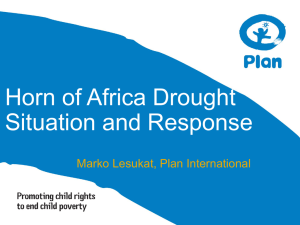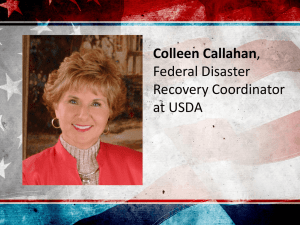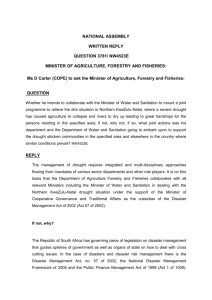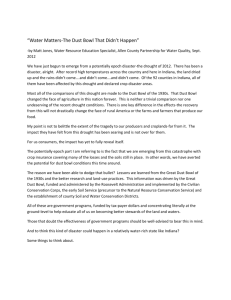Assignment 10
advertisement
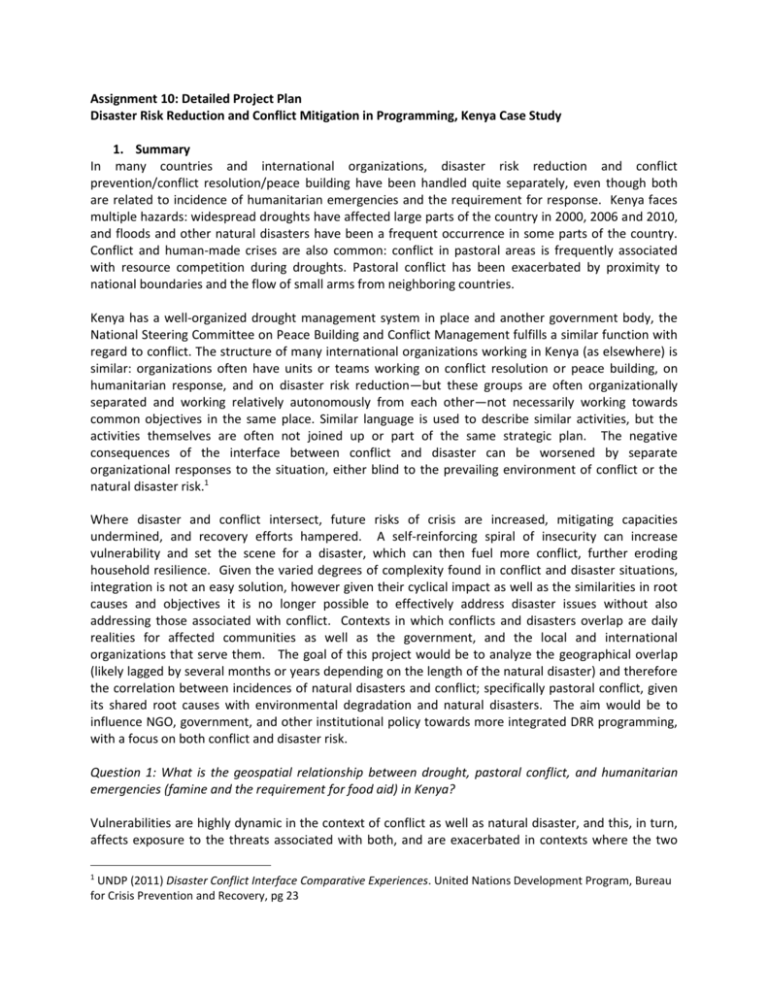
Assignment 10: Detailed Project Plan Disaster Risk Reduction and Conflict Mitigation in Programming, Kenya Case Study 1. Summary In many countries and international organizations, disaster risk reduction and conflict prevention/conflict resolution/peace building have been handled quite separately, even though both are related to incidence of humanitarian emergencies and the requirement for response. Kenya faces multiple hazards: widespread droughts have affected large parts of the country in 2000, 2006 and 2010, and floods and other natural disasters have been a frequent occurrence in some parts of the country. Conflict and human-made crises are also common: conflict in pastoral areas is frequently associated with resource competition during droughts. Pastoral conflict has been exacerbated by proximity to national boundaries and the flow of small arms from neighboring countries. Kenya has a well-organized drought management system in place and another government body, the National Steering Committee on Peace Building and Conflict Management fulfills a similar function with regard to conflict. The structure of many international organizations working in Kenya (as elsewhere) is similar: organizations often have units or teams working on conflict resolution or peace building, on humanitarian response, and on disaster risk reduction—but these groups are often organizationally separated and working relatively autonomously from each other—not necessarily working towards common objectives in the same place. Similar language is used to describe similar activities, but the activities themselves are often not joined up or part of the same strategic plan. The negative consequences of the interface between conflict and disaster can be worsened by separate organizational responses to the situation, either blind to the prevailing environment of conflict or the natural disaster risk.1 Where disaster and conflict intersect, future risks of crisis are increased, mitigating capacities undermined, and recovery efforts hampered. A self-reinforcing spiral of insecurity can increase vulnerability and set the scene for a disaster, which can then fuel more conflict, further eroding household resilience. Given the varied degrees of complexity found in conflict and disaster situations, integration is not an easy solution, however given their cyclical impact as well as the similarities in root causes and objectives it is no longer possible to effectively address disaster issues without also addressing those associated with conflict. Contexts in which conflicts and disasters overlap are daily realities for affected communities as well as the government, and the local and international organizations that serve them. The goal of this project would be to analyze the geographical overlap (likely lagged by several months or years depending on the length of the natural disaster) and therefore the correlation between incidences of natural disasters and conflict; specifically pastoral conflict, given its shared root causes with environmental degradation and natural disasters. The aim would be to influence NGO, government, and other institutional policy towards more integrated DRR programming, with a focus on both conflict and disaster risk. Question 1: What is the geospatial relationship between drought, pastoral conflict, and humanitarian emergencies (famine and the requirement for food aid) in Kenya? Vulnerabilities are highly dynamic in the context of conflict as well as natural disaster, and this, in turn, affects exposure to the threats associated with both, and are exacerbated in contexts where the two 1 UNDP (2011) Disaster Conflict Interface Comparative Experiences. United Nations Development Program, Bureau for Crisis Prevention and Recovery, pg 23 overlap. Interventions that do not account for this complex interplay have the potential to worsen tensions and increase risk. Furthermore, it is not enough for projects concerned with disaster and conflict risk reduction to run parallel of each other; instead interventions and analysis need to consider combined effects. A clearer realization about the cyclical and self-reinforcing nature of conflicts and natural disasters could lead to programming that would not accidentally exacerbate the risk of one while trying to reduce the risk of the other in areas prone to both. Question 2: What are some of the underlying and shared causes of drought and pastoral conflict in Kenya? There are several cross-cutting issues that increase both conflict and natural disaster risk. Politicaleconomic factors can lie at the root of conflict, such as limited government investments, high youth unemployment, and migration. A lack of cooperation over shared resources and poor environmental management can prolong conflicts and degrade the environment, increasing natural disaster and conflict risk. A better understanding of shared root causes could translate into more effective preventive programming that simultaneously addresses conflict and natural disaster risk. 2. Data Sources Data Source Armed Conflict Location and Events Data Set - Kenya Link Centre for the Study of Civil War (CSCW), International Peace Research Institute (PRIO), Oslo http://www.acleddata.com/ German Technical Cooperation (GTZ). 1996. The North Kenya GIS Database. United Nations Environment Programme (UNEP)/GRID-Nairobi. Nairobi: UNEP/GRID Nairobi http://www.wri.org/publication/c ontent/9291 District Boundaries (2001) National Road Network Major towns Ethnic Boundaries Precipitation (1995 – 2011) UN funded Second Administrative Level Boundaries (SALB) International Livestock Research Institute http://www.wri.org/publication/c ontent/9291 http://www.ilri.org/gis/ International Livestock Research Institute International Livestock Research Institute FEWS NET - Africa RFE Images Average annual rainfall in Kenya (1950-1990) Kenya drought years and humanitarian emergencies World Resource Institute http://www.ilri.org/gis/ http://www.ilri.org/gis/ http://earlywarning.usgs.gov/few s/africa/web/imgbulks4.php?img type=rf&spextent=a http://www.wri.org/publication/c ontent/9291 http://www.worldclim.org/ (1997 – 2010) Distance to water points (boreholes, etc) in northern Kenya (1996) Kenya National Disaster Management Report 1. http://www.kecosce.org/do wnloads/DRAFT_DISASTER_ MANAGEMENT_POLICY.pdf 3. Data Analysis The main analysis I will be utilizing will be the construction of a conflict vulnerability index. However prior to the index I will first do an analysis to show the correlation between conflict and drought. Using the armed conflict data I have extracted conflict based on ethnic clashes, raids, and clashes over pasture or water to create a variable only looking at ‘traditional conflict,’ mainly for the purpose of extracting election conflict which has different causal variables. For each year for which I have conflict data I have classified the year as either a drought or non-drought year based on Kenya’s annual disaster report. To show the correlation between drought and conflict I created a graph with ‘year’ on the x axis and incident of traditional conflict on the y axis. Furthermore, to create a spatial representation of this I broke up the conflict variable into conflict in the drought years and non-drought years and used kernel density analysis with the raster calculator to spatially show how density of conflict increases in drought years (subtracted non-drought conflict density from drought conflict density similar to the in-class Uganda conflict exercise). Once the correlation between drought and conflict has been established I will construct an index of vulnerability using several variables in combination with incidence of drought and conflict to identify areas prone to conflict. This will be composed of 6 variables and 5 categories based on the literature: 1. Population density a. Distance to road b. Distance to major town 2. Distance to water (boreholes, spring, rivers) 3. Distance to ethnic boundary 4. Distance to past conflict 5. Areas prone to drought To calculate the five distance variables (road, major town, water, ethnic boundary, incidence of conflict) I will be using the spatial analysis Euclidian distance tool and then reclassifying. The classes will be the same for each variable and based on the ‘distance to water’ variable which was already classified as: 1: within 5 kilometers 2: 5-10 kilometers 3: 10-15 kilometers 4: 15-20 kilometers 5: greater than 20 kilometers The greater the proximity the more vulnerable the area is to conflict. To calculate the drought component of the vulnerability index I will use the precipitation data. I have 36 individual observations per year for the relevant years to my study: 1997-2010. A drought is defined as 75% or less of the average rainfall. I also have average rainfall data for Kenya for the past 50 years. I will aggregate the precipitation data on a yearly basis, multiply it by 10 (only 36 observations per year, 360 days a year), divide it by the 50 year average annual data in order to get a fraction. I will then reclassify to create a binomial variable for each 1 square kilometer for which the data has spatial resolution (1=drought, 0=no drought). Areas that are affected by drought more consistently or even consecutively appear to have even greater incidences of conflict; therefore, I will aggregate the yearly binomial values and based on the final result reclassify them into 5 groups as with the distance variables above: from most to least vulnerable. The six reclassified variables will then be added together using the sum raster tool (and perhaps again reclassified using the reclassify tool) to create an overall vulnerability to conflict index. 4. Final Products The final products will consist of the following: 1. Line graph ‘year versus incident of traditional conflict’, identifying drought years and points of humanitarian disaster. 2. Kernel density map showing the increase in conflict during drought years (by standard deviation) I will also show 4 distance maps based on the above ‘1 to 5 vulnerability’ classification: 1. Population density map using a combination of distance to road and distance to major town. 2. Distance to water map 3. Distance to ethnic boundary map 4. Distance to incidence of conflict (all conflict, not just traditional) map 5. Drought vulnerability, the reclassified aggregated binomial drought/precipitation variable The final map will be the overall ‘Vulnerability to Conflict’ Map based on the summation of the above 5 maps reclassified to show different levels of vulnerability.
